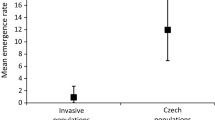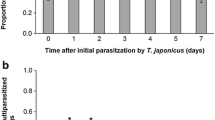Abstract
The Enemy Release Hypothesis (ERH) has been a factor influencing the establishment of some exotic species worldwide. We tested if the ERH could be influencing populations of the exotic predator Harmonia axyridis (Pallas) (Coleoptera: Coccinellidae) in Brazil. During two years, three local predatory coccinellid species and Harmonia axyridis were sampled in Brassica oleracea in six organic farms in the midwest of the country. Parasitoids were detected by rearing (emerged) and qPCR Melting Curve Analysis (unemerged). Host density-dependence and spillovers were used to evaluate coccinellid population effects of parasitism. Six parasitoid species were found, including two new records for Brazil. Although Harmonia axyridis harbored fewer parasitoid species, parasitism was not lower and parasitoid density-dependence was not weaker on it compared to the local species. Spillovers among hosts occurred both onto Harmonia axyridis and from it. The ERH was rejected for these parasitoids and, therefore, it did not contribute to the invasiveness of Harmonia axyridis in Brazil.




Similar content being viewed by others
References
Almeida LM, Silva VB (2002) First record of Harmonia axyridis (Pallas) (Coleoptera, Coccinellidae): a lady beetle native to the Palaearctic region. Rev Bras Zool 19:941–944
Arnaud PH, Jr (1978) Host parasite catalog of North American Tachinidae (Diptera) Miscellaneous publication No. 1319. Science and Education Administration, United States Department of Agriculture
Arruda Filho GP, Berti-Filho E, Pereira RA (2009) Occurrence of Harmonia axyridis (Pallas) (Coleoptera, Coccinellidae) in the state of São Paulo, Brazil. Rev Agric 84(2):145–148
Berkvens NJ, Moens J, Berkvens D, Samih MA, Tirry L, De Clercq P (2010) Dinocampus coccinellae as a parasitoid of the invasive ladybird Harmonia axyridis in Europe. Biol Control 53:92–99
Ceryngier P, Hodek I (1996) Enemies of Coccinellidae. In: Hodek I, Honek A (eds) Ecology of Coccinellidae. Kluwer Academic Publishers, Dordrecht, pp 319–350
Ceryngier P, Roy HE, Poland RM (2012) Natural enemies of ladybird beetles. In: Hodek I, van Emden HF, Honek A (eds) Ecology and behaviour of ladybird beetles (Coccinellidae). Wiley-Blackwell, Chichester, pp 375–443
Ceryngier P, Nedvěd O, Grez AA, Riddick EW, Helen ER, Gilles SM, Tove S, Petr V, Tania Z, Álvaro Z-R, Danny H (2018) Predators and parasitoids of the harlequin ladybird, Harmonia axyridis, in its native range and invaded areas. Biol Invasions 20(4):1009–1031
Clausen CP (1978) Introduced parasites and predators of arthropod pests and weeds: a world review. US Department of Agriculture Handbook 480
Colautti RI, Ricciardi A, Grigorovich IA, MacIsaac HJ (2004) Is invasion success explained by the enemy release hypothesis? Ecol Lett 7:721–733
Comont RF, Purse BV, Phillips W, Kunin WE, Hanson M, Lewis OT, Harrington R, Shortall CR, Rondoni G, Roy HE (2014) Escape from parasitism by the invasive alien ladybird, Harmonia axyridis. Insect Conserv Divers 7:334–342
de Castro-Guedes CF, de Almeida LM (2016) Laboratory investigations reveal that Harmonia axyridis (Coleoptera: Coccinellidae) is a poor host for Dinocampus coccinellae (Hymenoptera: Braconidae) in Brazil. J Insect Sci 16(1):55
de Castro-Guedes CF, Dios RDVP, de Almeida LM (2018) Parasitism of Harmonia axyridis (Pallas) (Coleoptera: Coccinellidae) by Strongygaster brasiliensis (Townsend) (Diptera: Tachinidae). EntomoBrasilis 11:49–51
Disney RHL (1979) Natural history notes on some British Phoridae (Diptera) with comments on a changing picture. Entomol Gaz 30:141–150
Disney RHL, Majerus MEN, Walpole MJ (1994) Phoridae (Diptera) parasitising Coccinellidae (Coleoptera). Entomologist 113:28–42
Dzhanokmen KA (2009) Review of Kazakhstan species of the genus Pachyneuron Walker, 1833 (Hymenoptera: Chalcidoidea: Pteromalidae). Zoosystematica Rossica 18:73–82
Elton CS (1958) The ecology of invasions by animals and plants. University of Chicago Press, Chicago
Firlej A, Girard PA, Brehélin M, Coderre D, Boivin G (2012) Immune response of Harmonia axyridis (Coleoptera: Coccinellidae) supports the enemy release hypothesis in North America. Ann Entomol Soc Am 105(2):328–338
Goedknegt MA, Schuster AK, Buschbaum C, Gergs R, Jung AS, Luttikhuizen PC, van der Meer J, Troost K, Wegner KM, Thieltges DW (2017) Spillover but no spillback of two invasive parasitic copepods from invasive Pacific oysters (Crassostrea gigas) to native bivalve hosts. Biol Invasions 19(1):365–379
González G (2011) Los Coccinellidae de Brasil https://www.coccinellidae.cl/paginasWebBra/Paginas/InicioBra.php. Accessed 04 Feb 2020
Hall RW, Ehler LE, Bisabri-Ershadi B (1980) Rate of success in classical biological control of arthropods. Bull ESA 26(2):111–114
Harterreiten-Souza ÉS, Togni PHB, Milane PVGN, Cavalcante KR, Medeiros MA, Pires CSS, Sujii ER (2012) Seasonal fluctuation in the population of Harmonia axyridis (Pallas, 1773) (Coleoptera: Coccinellidae) and co-occurrence with other coccinellids in the Federal District of Brazil. Pap Avulsos de Zool 52(11):134–140
Hassell MP (1984) Parasitism in patchy environments: inverse density dependence can be stabilizing. IMA J Math Appl Med Biol 1(1):123–133
Hiller T, Haelewaters D (2019) A case of silent invasion: citizen science confirms the presence of Harmonia axyridis (Coleoptera, Coccinellidae) in Central America. PLoS ONE 14(7):e0220082
Honek A, Martinkova Z, Ceryngier P (2019) Different parasitization parameters of pupae of native (Coccinella septempunctata) and invasive (Harmonia axyridis) coccinellid species. Bull Insectol 72(1):77–83
Iperti G (1964) Les parasites des coccinelles aphidiphages dans les Alpes-Maritimes et les Basses-Alpes. Entomophaga 9:153–180
Kelly DW, Paterson RA, Townsend CR, Poulin R, Tompkins DM (2009) Parasite spillback: a neglected concept in invasion ecology? Ecology 90:2047–2056
Koch R, Fernandes M, Dutra C (2016) First confirmed record of Harmonia axyridis (Pallas, 1773) (Coleoptera: Coccinellidae) in the state of Mato Grosso do Sul, Brazil. Check List 7:476–477
Koyama S, Majerus MEN (2008) Interactions between the parasitoid wasp Dinocampus coccinellae and two species of coccinellid from Japan and Britain. BioControl 53:253–264
Liu H, Stiling P (2006) Testing the enemy release hypothesis: a review and meta-analysis. Biol Inv 8:1535–1545
Lombaert E, Guillemaud T, Cornuet J-M, Malausa T, Estoup A (2010) Bridgehead effect in the worldwide invasion of the biocontrol harlequin ladybird. PLoS ONE 5(3):e9743
Martins CBC, Almeida LM, Zonta-de-Carvalho RZ, Castro CF, Pereira RA (2009) Harmonia axyridis: a threat to Brazilian Coccinellidae? Rev Bras Entomol 53(4):663–671
Noyes JS (2019) Universal Chalcidoidea database. World Wide Web electronic publication. https://www.nhm.ac.uk/chalcidoids
O’Hara JE, Henderson SJ, Wood DM (2019) Preliminary checklist of the Tachinidae of the world. Version 1.0. PDF document. https://www.nadsdiptera.org/Tach/WorldTachs/Checklist/Worldchecklist.html. Accessed 2 Feb 2020
Osawa N (1992) Effect of pupation site on pupal cannibalism and parasitism in the ladybird beetle Harmonia axyridis Pallas (Coleoptera, Coccinellidae). Jpn J Entomol 60:131–135
Park HC, Park YC, Hong OK, Cho SY (1996) Parasitoids of the aphidophagous ladybeetles, Harmonia axyridis (Pallas) (Coleoptera: Coccinellidae) in Chuncheon areas, Korea. Korean J Entomol 26:143–147
Pimenta HR, Smith JG (1976) Afídeos, seus danos e inimigos naturais em plantação de trigo (Triticum sp.) no estado do Paraná. Organização das Cooperativas do Paraná (OCEPAR), Curritiba, Paraná, Brasil
Podoler H, Rogers D (1975) A new method for the identification of key factors from life-table data. J Anim Ecol 44(1):85–114
R Core Team (2013) R: a language and environment for statistical computing. R Foundation for Statistical Computing, Vienna, Austria. https://www.r-project.org/
Rezende MQ, Campos JLA, Coelho LMB, Santana DLQ (2010) Coleoptera, Coccinellidae, Harmonia axyridis (Pallas, 1773): New record in Minas Gerais, southeastern Brazil. Check List 6(3):465–466
Riddick EW, Cottrell TE, Kidd KA (2009) Natural enemies of the Coccinellidae: parasites, pathogens, and parasitoids. Biol Control 51:306–312
Romanov DA (2019) Parasitoids of the harlequin ladybeetle Harmonia axyridis (Pallas, 1773) (Coleoptera: Coccinellidae). Russ J Biol Invasions 10:52–67
Roy HE, Brown PMJ, Rothery P, Ware RL, Majerus MEN (2008) Interactions between the fungal pathogen Beauveria bassiana and three species of coccinellid: Harmonia axyridis, Coccinella septempunctata and Adalia bipunctata. BioControl 53:265–276
Roy HE, Handley LJL, Schönrogge K, Poland RL, Purse BV (2011) Can the enemy release hypothesis explain the success of invasive alien predators and parasitoids? BioControl 56(4):451–468
Roy HE, Brown PMJ, Adriaens T, Berkvens N, Borges I, Clusella-Trullas S, Comont RF, De Clercq P, Eschen R, Estoup A, Evans EW, Facon B, Gardiner MM, Gil A, Grez AA, Guillemaud T, Haelewaters D, Herz A, Honek A, Howe AG, Hui C, Hutchison WD, Kenis M, Koch RL, Kulfan J, Handley LL, Lombaert E, Loomans A, Losey J, Lukashuk AO, Maes D, Magro A, Murray KM, Martin GS, Martinkova Z, Minnaar IA, Nedved O, Orlova-Bienkowskaja MJ, Osawa N, Rabitsch W, Ravn HP, Rondoni G, Rorke SL, Ryndevich SK, Saethre M-G, Sloggett JJ, Soares AO, Stals R, Tinsley MC, Vandereycken A, van Wielink P, Viglášová S, Zach P, Zakharov IA, Zaviezo T, Zhao Z (2016) The harlequin ladybird, Harmonia axyridis: global perspectives on invasion history and ecology. Biol Invasions 18:997–1044
Saini ED (2004) Presencia de Harmonia axyridis (Pallas) (Coleoptera: Coccinellidae) en la provincia de Buenos Aires. A Biol Morfol 33:151–160
Shapiro-Ilan DI, Cottrell TE (2005) Susceptibility of lady beetles (Coleoptera: Coccinellidae) to entomopathogenic nematodes. J Invertebr Pathol 89(2):150–156
Shea K, Chesson P (2002) Community ecology theory as a framework for biological invasions. Trends Ecol Evol 17:170–176
Silva RB, Cruz I, Figueiredo MLC, Pereira AG, Penteado-Dias AM (2012) Occurrence and biology of Dinocampus coccinellae (Schrank, 1802) (Hymenoptera; Braconidae: Euphorinae) parasitising different species of Coccinellidae (Coleoptera) in Neotropical region. Braz J Biol 72(1):215–219
Smith BC (1960) Note on parasitism of two coccinellids, Coccinella trifasciata perplexa Muls. and Coleomegilla maculata lengi Timb. (Coleoptera: Coccinellidae) in Ontario. Can Ent 92:652
Togni PHB, Souza LM, Sicsú PR, Costa VA, Amaral DSSL, Franco AC, Sujii ER, Venzon M (2015) Coccinellidae parasitoids in Brazil: neglected species in a megadiverse country. Neotrop Entomol 44(5):528–532
Torchin ME, Lafferty KD, Dobson AP, McKenzie VJ, Kuris AM (2003) Introduced species and their missing parasites. Nature 421:628–630
Turchin P (1990) Rarity of density dependence of population regulation with lags? Nature 344:660–663
Varley GC, Gradwell GR, Hassell MP (1973) Insect population ecology: an analytical approach. U Cal, Berkeley
Acknowledgements
We thank J.R. Pujol Luz (Universidade de Brasília, Brazil) for identification for Strongygaster triangulifera, and all the farmers that allowed the host samplings in 2017 and 2018. We also thank Iane P. Ferreira, Karina S. Kubota and Stephanie S. Ribeiro for help in sampling hosts. We also thank Embrapa for the financial support by the grant number SEG 12.13.12.005.00.00 and CAPES Print and the Graduate Program from the Department of Ecology, Universidade de Brasília, Brazil, for the fellowship to DAA.
Author information
Authors and Affiliations
Corresponding author
Ethics declarations
Conflict of interest
The authors declare that they have no conflict of interest.
Additional information
Handling Editor: Barbara Barratt.
Electronic supplementary material
Below is the link to the electronic supplementary material.
Rights and permissions
About this article
Cite this article
Paula, D.P., Togni, P.H.B., Costa, V.A. et al. Scrutinizing the enemy release hypothesis: population effects of parasitoids on Harmonia axyridis and local host coccinellids in Brazil. BioControl 66, 71–82 (2021). https://doi.org/10.1007/s10526-020-10041-y
Received:
Accepted:
Published:
Issue Date:
DOI: https://doi.org/10.1007/s10526-020-10041-y




